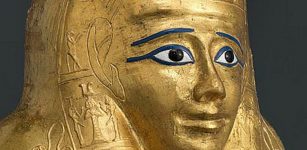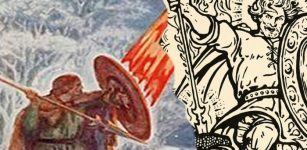Empusa – Shape-Shifting Evil Female Demon In Greek Myth And Folklore
A. Sutherland - AncientPages.com - The empusa initially appears in the mythology of classical Greece as a frightening female monster. She is a demonic vampire without a shape of its own, but with the ability to appear in many different animal guises and as a beautiful, tempting young woman.
Credit: Adobe Stock - Joeprachatree
Modern-day Greek folklore still speaks of the empusa, who enters the body of its human prey (particularly children) to consume the flesh and blood of its victim. She loves to eat young and beautiful bodies and drink their blood because it’s strong and pure.
Empusa represents the Grecian form of a vampire. In the Greek myth, this female demon is usually described as having one prosthetic leg made of brass and the other leg of a donkey; from the waist up, Empusa is a human-like creature with hideous blemishes and scars on her skin.
She was said to have been the daughter of the goddess of witchcraft, the night, moon, ghosts, and necromancy, Hekate, and was sent by her to torment people, especially travelers.
This evil creature seeks its prey, and as the shape-shifter changes its apparition into an animal or a beautiful woman. She drinks her victims’ blood and consumes their flesh (like a vampire or succubus). The monster thrives in waters and on land, so it usually dwells along the coast.
An ancient story about a 25-year-old man of Lycia, Menippus, who is intelligent, handsome, and exceptionally well-built as an athlete, relates an encounter with this evil creature. One day, as Menippus walks along the road, he is met by an apparition. Empusa appears in the guise of a Phoenician woman, and Menippus lives under her spell. He falls in love with her and plans to marry her, unaware of what she is.
Apollonius is somewhat skeptical of her; he attends the wedding and is introduced to her by Menippus of Corinth, his former student. This wealthy woman is the mistress of all the servants. Hearing this, Apollonius tells Menippus that his wonderful bride is nothing but a vampire who – like others in her race - loves to devour flesh and blood of its victims.
Apollonius of Tyana made the young woman confess her true identity, thereby rescuing Menippus from a terrible fate on his wedding night.
Menippus’ bride is offended and orders Apollonius to leave, but his words have already broken her spell, and all the gold, silver, and servants vanished.
Pretending to weep, this demonic creature begs Apollonius not to force her to confess what she is, but he does. Finally, she admits she usually chooses her offers among young and beautiful people to dine on them, and Menippus is one of them.
Belief in this evil monster persists into modern times. Present-day shepherds blame her for accidents that happen to their animals, claiming that she suddenly appears, hurts them, and disappears again. Later tales describe a whole race of these monsters - the Empusae - living on the North African coast in Libya.
The ’Empusa’ is the early Greek term for the later Latin term ‘lamia.’ Over the ages, the descriptions of this female demon changed considerably and were often confused with Lamia
Ancient people believed that the only defense against these monsters was abusing them verbally or shouting insults. As a result, they screamed and fled their way.
Except for the Greek account of Empusa, the same awful creature is known in other ancient cultures of the Mediterranean region.
Written by – A. Sutherland AncientPages.com Staff Writer
Copyright © AncientPages.com All rights reserved. This material may not be published, broadcast, rewritten or redistributed in whole or part without the express written permission of AncientPages.com
Expand for referencesReferences:
Grant M, Hazel J. Who's Who in Classical Mythology
March J. R. Dictionary of Classical Mythology
More From Ancient Pages
-
 Mysterious Stone Of The Sky God: Krishna’s Butter Ball Defies All Laws Of Physics
Featured Stories | Aug 20, 2014
Mysterious Stone Of The Sky God: Krishna’s Butter Ball Defies All Laws Of Physics
Featured Stories | Aug 20, 2014 -
 Evidence Humans Used Fire 1 Million Years Ago In Israel Discovered By Artificial Intelligence
Archaeology | Jun 15, 2022
Evidence Humans Used Fire 1 Million Years Ago In Israel Discovered By Artificial Intelligence
Archaeology | Jun 15, 2022 -
 On This Day In History: Sorley MacLean, A World Renowned Gaelic Poet, Died – On Nov 24, 1996
News | Nov 24, 2016
On This Day In History: Sorley MacLean, A World Renowned Gaelic Poet, Died – On Nov 24, 1996
News | Nov 24, 2016 -
 Gilded Coffin Of Nedjemankh, Priest Of Ram-God Heryshef Recovered By Egyptian Authorities
Archaeology | Mar 12, 2019
Gilded Coffin Of Nedjemankh, Priest Of Ram-God Heryshef Recovered By Egyptian Authorities
Archaeology | Mar 12, 2019 -
 Anartes: Forgotten Celtic Tribe And The Hercynian Forest With Strange Animals
Civilizations | Jun 14, 2016
Anartes: Forgotten Celtic Tribe And The Hercynian Forest With Strange Animals
Civilizations | Jun 14, 2016 -
 On This Day In History: Battle Of Durnstein Was Fought On The River Danube – On Nov 11, 1805
History | Nov 11, 2016
On This Day In History: Battle Of Durnstein Was Fought On The River Danube – On Nov 11, 1805
History | Nov 11, 2016 -
 Queen Elizabeth I Was Identified As Author Of Tacitus’s Annales Translation
News | Dec 1, 2019
Queen Elizabeth I Was Identified As Author Of Tacitus’s Annales Translation
News | Dec 1, 2019 -
 Spir Mountain Cairns: Prehistoric Ancient Monuments To The Dead In Northern Sweden
Featured Stories | Jan 12, 2022
Spir Mountain Cairns: Prehistoric Ancient Monuments To The Dead In Northern Sweden
Featured Stories | Jan 12, 2022 -
 Statue Of Greek Health Goddess Hygieia – Unearthed
Archaeology | Aug 24, 2021
Statue Of Greek Health Goddess Hygieia – Unearthed
Archaeology | Aug 24, 2021 -
 Ancient Knowledge About Horse Taming Is Rewriting Our Picture Of The Past
Archaeology | Jan 27, 2022
Ancient Knowledge About Horse Taming Is Rewriting Our Picture Of The Past
Archaeology | Jan 27, 2022 -
 Meteora – A Sanctuary Of Harmony And Quietness “Hanging” In The Sky
Civilizations | Aug 14, 2015
Meteora – A Sanctuary Of Harmony And Quietness “Hanging” In The Sky
Civilizations | Aug 14, 2015 -
 On This Day In History: England’s Act Against Multipliers Signed Into Law – On Jan 13, 1404
News | Jan 13, 2017
On This Day In History: England’s Act Against Multipliers Signed Into Law – On Jan 13, 1404
News | Jan 13, 2017 -
![Horses in the Eurasian steppes: Already 5000 years ago, they served pastoralists as a source of milk and a means of… [more] © A. Senokosov](https://www.ancientpages.com/wp-content/uploads/2021/09/pastoraliststeppe15-307x150.jpg) Milk Enabled Massive Steppe Migration – A New Study
Archaeology | Sep 24, 2021
Milk Enabled Massive Steppe Migration – A New Study
Archaeology | Sep 24, 2021 -
 Star-Shaped Magnetic Anomaly At Hidden Stone Circle In The Outer Hebrides Gives New Insight Into Ancient Beliefs
Archaeology | Jan 2, 2020
Star-Shaped Magnetic Anomaly At Hidden Stone Circle In The Outer Hebrides Gives New Insight Into Ancient Beliefs
Archaeology | Jan 2, 2020 -
 Why Did Vikings Carry Decorative Swords That Were Useless In Combat?
Ancient History Facts | Dec 19, 2017
Why Did Vikings Carry Decorative Swords That Were Useless In Combat?
Ancient History Facts | Dec 19, 2017 -
 Ancient Burial Tomb Of A Noble Mongol Warrior With Weapons Unearthed In The Moldavian Village
Archaeology | Aug 9, 2022
Ancient Burial Tomb Of A Noble Mongol Warrior With Weapons Unearthed In The Moldavian Village
Archaeology | Aug 9, 2022 -
 Aboriginal ‘Memories’ Of Australia’s Coastline Go Back More Than 7,000 Years
Civilizations | Sep 30, 2015
Aboriginal ‘Memories’ Of Australia’s Coastline Go Back More Than 7,000 Years
Civilizations | Sep 30, 2015 -
 Roman Mosaic Dated To Between 60 BC And 300 AD Unearthed In Baalbek
Archaeology | Dec 30, 2020
Roman Mosaic Dated To Between 60 BC And 300 AD Unearthed In Baalbek
Archaeology | Dec 30, 2020 -
 Giant Meteorite Impacts Created The Continents – Evidence Found
Human Beginnings | Aug 12, 2022
Giant Meteorite Impacts Created The Continents – Evidence Found
Human Beginnings | Aug 12, 2022 -
 Fionn Mac Cumhail: Legendary Irish Hero, Clairvoyant And Leader Of Fianna Warriors
Celtic Mythology | Oct 11, 2019
Fionn Mac Cumhail: Legendary Irish Hero, Clairvoyant And Leader Of Fianna Warriors
Celtic Mythology | Oct 11, 2019

